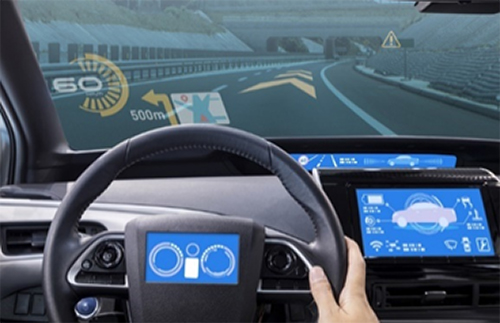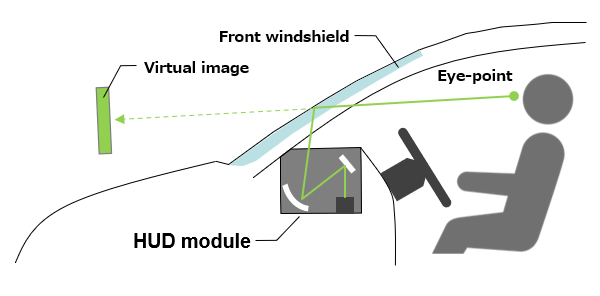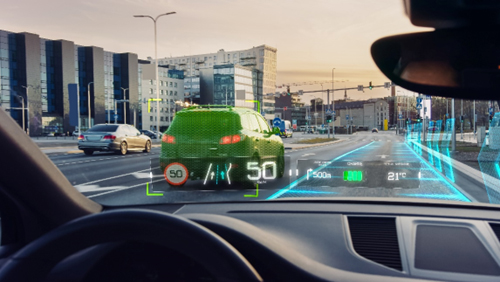What is AR-HUD?
AR-HUD (Augmented Reality Head-up Display) is a system for displaying navigation, ADAS function warning, and important information on the road on the front windshield overlapping with the driver’s real view.

Application points of the 6in1 sensor in AR-HUD
- 6in1 sensor detects vibration and tilt of the vehicle (projector) and suppresses the mismatch between the driver’s real view and displayed image by using optical axis mismatch correction.
- Preventing abnormal mismatch correction by using the self-diagnosis function and temperature characteristics correction function
- Improving the degree of freedom in the module attachment position and reducing BOM cost by using 6-axis detection
Effect of adopting 6in1 sensors for AR-HUD
Effect (1): 6in1 sensor detects vibration and tilt of the vehicle (projector) and suppresses the mismatch between the driver’s real view and displayed image by using optical axis mismatch correction
AR-HUD projects the required information on the front windshield emitted from the projector, but when the projector position is shifted by vibration or tilt, the projected light-beam direction may possibly be shifted or blurred. By detecting this vibration and tilt with a 6in1 sensor and correcting the light-beam direction from the projector, it is possible to display images always in the correct position.
【Point】
- By using rapid response of the gyro-sensor, beam shifting caused by vehicle vibration can be corrected in real-time.

Effect (2): Preventing abnormal correction by using the self-diagnosis function and temperature characteristics correction function
Because AR-HUD is capable of displaying the turning direction of the driver on top of actual road image, when the displayed image shifts from the correct position, the driver may ignore the actual road condition and follow the wrong information, thereby causing an accident. For this reason, the inertial sensor used for AR-HUD generally requires a self diagnosis function.
Because the Panasonic 6in1 sensor is equipped with 3-axis acceleration sensor and 3-axis gyro sensor in a single chip MEMS with a diagnosis function in all 6 axes while conforming to ASIL-B(D), it is the best-fit sensor for use with AR-HUD.
In addition, every 6in1 sensor receives temperature characteristics correction in all temperature ranges minimizing the effect on image deviation correction caused by heat dissipation by projector and peripheral components, and temperature change in the vehicle compartment.
【Point】
- Conformance to ASIL-B(D) and the self-diagnosis function in all axes prevents a displayed image shift of AR-HUD, thereby contributing to improved system safety. In addition, the temperature correction function minimizes the influence of image shifting correction caused by temperature changes.

Effect (3): Improving the freedom of the installation position by the customer and reducing BOM cost is facilitated by the 6-axis detection.
The Panasonic 6in1 sensor enables detection in all 6 axes using a single chip, allowing vehicle installation of the customer’s module in all angles and attitudes. In addition, conformance to functional safety in a single chip eliminates the need for mounting multiple chips, allowing BOM cost reduction from the previous design requirement.
【Point】
- 6-axis 1-chip functional safety sensor achieves the industry’s smallest sized level (surveyed by the company), contributing to the freedom of the installation position and BOM cost reduction.
